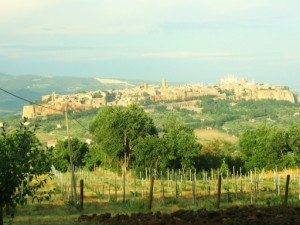 Our territory, between history and nature.
Our territory, between history and nature.
Orvieto: Etruscan town, perched high on a volcanic outcrop of ancient origin, its old town on a human scale is rich in medieval and Renaissance palaces, churches, Etruscan tombs and the remains of Etruscan origin set out in the archaeological and civic museums. Orvieto also has unique monuments of its kind as The Duomo Cathedral and St. Patrick’s Well. We recommend a visit to the Pozzo della Cava, the Torre del Moro, the Palazzo del Capitano del Popolo and the city’s underground (Orvieto Underground). The city is also the scene of important events and music festivals. Among the major annual events we highlight the feast of Corpus Christi with the historical parade, Umbria Jazz Winter and Umbria Folk Festival. For more information about the city of Orvieto and what to see:
www.orvietoviva.com/en/
Other points of interest in the area:
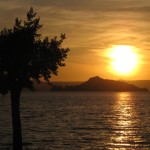
Bolsena and Bolsena Lake (14 km). Along the Cassia
road towards Viterbo, the great lake of Bolsena is just a few minutes from our property, one of the cleanest in Europe and a popular destination for lake tourism. The lake, of volcanic origin, is dotted along its perimeter
by villages and beaches both free and with small establishments and restaurants. Bolsena is a town of Etruscan origin and is together, with the other main town Orvieto, in the celebration of the Extraordinary Eucharist
Jubilee for the 750th anniversary of the “Miracle of Bolsena.” In town, we strongly suggest a visit to the beautiful basilica of Santa Cristina and the Monaldeschi Castle, current home of the territorial museum. From Bolsena guests can also easily reach the charming village of Capodimonte, from where ferry boats for tours on the lake and the islands depart. Always around the perimeter of the lake are other villages to visit, including San Lorenzo Nuovo and Marta. Continuing in the direction of Viterbo instead, you reach the center of Montefiascone with the beautiful Fortress of the Popes and the church of Santa Margherita.
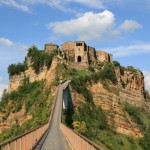 Civita di Bagnoregio (12 km) A unique place in the world, just a short drive towards the town of Bagnoregio, Viterbo direction. The village of Civita, a town now almost deserted connected to the rest of the world by a long and impressive bridge that can only walked on foot. A visit to this village is absolutely recommended to find yourself in a fairy tale
Civita di Bagnoregio (12 km) A unique place in the world, just a short drive towards the town of Bagnoregio, Viterbo direction. The village of Civita, a town now almost deserted connected to the rest of the world by a long and impressive bridge that can only walked on foot. A visit to this village is absolutely recommended to find yourself in a fairy tale
out of time. Very nice are also the landscape that you find around the picturesque valley of the Badlands and the nearby natural park of Lubriano: a journey through the green for nice relaxing walks in the unexploited nature. Torre Alfina: another village of the Tuscia area in Lazio who, as Civita, is ranked among the most beautiful in Italy. The entire village is nestled in a verdant countryside, and is dominated by an impressive castle (the Monaldeschi Castle) a beautiful medieval building with high towers and a precious Italian garden. Near the castle there is a “monumental” forest with huge rocks and tall trees, and embedded in this nature is the Gothic mausoleum of the noble Marquis Cahen to whom we owe the construction of the spectacular art nouveau villa (Villa La Selva or Villa Cahen) nestled in the woods of the di Meana forest near the village of Allerona.
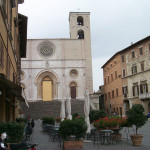 Todi (about half an hour by car). This beautiful Umbrian town can be reached by passing through the area of Lake Corbara and the Tiber River Park, a protected and very scenic and picturesque environment ideal for lovers of sports like fishing, hiking or mountain biking. In the town of Todi we recommend a visit to the center, with its beautiful Piazza del Popolo, the Duomo, Palazzo dei Priori, and the Roman cisterns. Just outside of town we recommend the majestic Santuario della Consolazione. Near Todi is also the small village of Monte Castello di Vibio, reported among the most beautiful villages of Umbria and where the original “little theater” is. As the name suggests, it is the smallest theater in the world.
Todi (about half an hour by car). This beautiful Umbrian town can be reached by passing through the area of Lake Corbara and the Tiber River Park, a protected and very scenic and picturesque environment ideal for lovers of sports like fishing, hiking or mountain biking. In the town of Todi we recommend a visit to the center, with its beautiful Piazza del Popolo, the Duomo, Palazzo dei Priori, and the Roman cisterns. Just outside of town we recommend the majestic Santuario della Consolazione. Near Todi is also the small village of Monte Castello di Vibio, reported among the most beautiful villages of Umbria and where the original “little theater” is. As the name suggests, it is the smallest theater in the world.
Routes and nature trails:
For those who love nature, below are some recommended hiking trails.
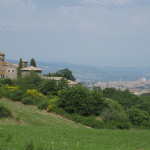 Excursion Anello del Monte Tigno – Fonti del Tione
Excursion Anello del Monte Tigno – Fonti del TioneFrom the former convent of the Trinity turn right into a dirt road going up and down all the way to Sugano. We are near the Sasso Tagliato area
and already from here you can enjoy superb views of Orvieto. The boulder that gives the name to the locality, according to religious tradition, opened the procession that brought to Orvieto the sacred body of the miracle
of Corpus Christi, which occurred in Bolsena. Continuing through the woods of the Macchia dei Frati and crossing the Pontesasso ditch, we arrive at the bottom of the village of Sugano (410m): a small Fourteenth Century fortified village. The vertical wall on which stands the village of Sugano is characterized by the presence of numerous sources, one of which supplies the series of basins which constitute one of the oldest public washrooms, located at the base of the basalt cliff. Departing from this area and once left the paved road that climbs up around the village, we will find ourselves past the junction for Fraschetta, and reachthe water sources of Tione (380 m): this is a source of mineral water that flows directly by the powerful layer of volcanic rocks that lie at the bottom of the village. This sources are always appreciated for the quality and purity of water, who supplied in the past a brick kiln, two mills for wheat and one for oil and, subsequently, were also used for breeding otters. Today of the old power station has not remained anything else than a ruin overgrown by plants and two rusty turbines, while the sources have been exploited since 1991 for water bottling industry, although the local authorities have preserved some public sources at the very source. From the sources you climb up a dirt road and you will arrive at the Castle of San Quirico (435 m), dating from the Thirteenth Century and renovated in the ‘800. At this point, reached the edge of the plateau, the landscape changes and becomes more open, with cultivated fields, farms, monumental oak trees all around, farmhouses and small wooded
areas.Once you leave this ancient parish which was owned by Orvieto during the Middle Ages, you turn onto an old dirt road that takes you through the woods and then goes up to Monte Tigno. These areas offer a wonderful view of Orvieto and of the other tufa rock called Rocca Ripesena. This rocca, especially during sunset, takes a beautiful red color. After turning right, continue along the path in the woods, which is mainly characterized by the presence of oaks, chestnut trees, as well as many wonderful plants. This path, passing by the farm Sossogna,
brings us back down to the road to Rocca Ripesena (368 m), a small town that looks like a miniature Orvieto. This borough is situated in a panoramic position and rests on a volcanic rock which is believed (as well as other rock called Rocca Sberna) had the same origin of the rock of Orvieto.
